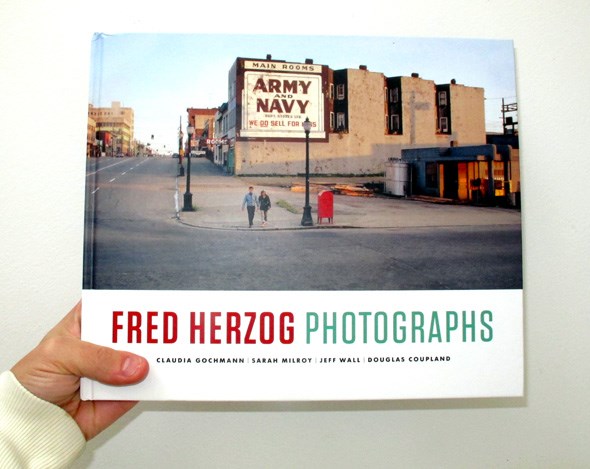The introductory essay in the latest collection of Fred Herzog's photography (Fred Herzog: Photographs, published by D+M), has art historian Claudia Gochmann breaking down the technicalities of this legendary Vancouver photographer's work and notes his "virtuosic handling of colour". She goes on to call him "a pioneer in the development of colour photography as an art form" and that William Eggleston and Stephen Shore further pursued this path after our Vancouver protagonist picked it up. You can't argue with that.
In the next essay - there are four of them preceding 170 pages of photographs - Sarah Milroy takes us on a detailed journey through Fred's life. From grade school in Nazi Germany to hopping on a steamship bound for Montreal in the 1950's and then a train to Vancouver and the hows and whys of his work in photography, she describes the life that has brought him to "become the master of the subtle moment when gesture and context meet in ways that allow us to read the condition of our fellow human beings". No argument there, either.

My single argument lies with Jeff Wall's essay where he praises Herzog and his work while putting forth the criticism that zoning and "new standards in taste in building types and materials" in Vancouver have made the place unlovable. He further claims that we will never again see a photographer like Herzog here because there's nothing left to be affectionate about concerning the aesthetics of our city, and I (quite obviously) disagree with that, and not just for the obvious reasons like my assumed obligation to disagree with it for the sake of the spirit behind this very web site. My feeling is that while the city certainly has changed over the decades since Herzog produced what is likely considered his most interesting work for our contemporary eyeballs, it's a moot point that Vancouver may or may not be uglier or prettier. I will agree that most of the architecture within Vancouver today isn't as romantic as the subject matter in Photographs, but what makes Herzog's work truly great is that it captured the reality of the people who inhabited those buildings that Wall bemoans are now missing from our streets. The human condition (as I quoted in the previous paragraph) is what he captured so well and as long as there are still people living in the "justified" denser buildings in our neighbourhoods then there will be artists born amongst them who will capture their condition and deliver it to the walls of galleries and the pages of Douglas & McIntyre books for another 40 years to come. While I love and respect Jeff's work as a fine art photographer I disagree with his take on the good old days and that the new generations of artists have been crippled by the decisions made decades before they were born. He ends his critique by saying that for their sake he hopes that photographers of tomorrow will prove him wrong, and I also hope that artists born in the 1990's are up for the challenge he puts them to!
Douglas Coupland wraps up these four pieces about Fred and his work by speaking of pre-1975 Vancouver and fond memories of an old burger joint near Stanley Park called the Taxan Burger. He notes how dirty the city was compared to today as it stands all cleaned up, shiny and ecologically friendly. Doug says that "He [Herzog] certainly wasn't out to take pretty pictures" and that "We are all so much more the richer fot it". That pretty much sums up my feelings about this title, that I am richer for having it on our shelf here at the V.I.A. office.
Details on where to pick it up are available HERE. Be sure to have a look at this video below of 81 year old Fred Herzog himself flipping through the colour proofs of the book during one of the final editing stages. You'll note that the cover which makes an appearance in this isn't the one that made it to print, and if you're keen you might notice a couple of other subtleties...
http://www.youtube.com/watch?v=MkMNgfvQL2E


